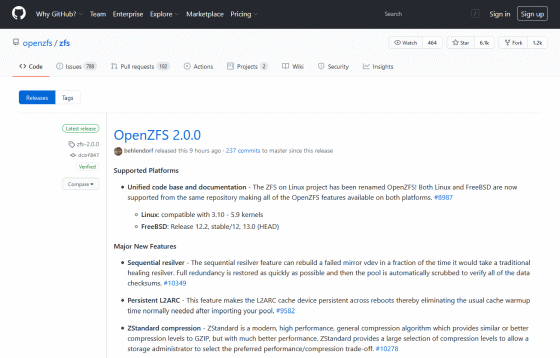

If you are resizing your root filesystem to make room, you will need a live disk such as the GParted Live Disk.Īfterwards, run the following command to create a new zpool: sudo zpool create -m /your/mount/point yourpoolname /dev/sdXY Repartition another drive using your preferred partition managing tool, such as GParted. ZFS is possible to use as a root filesystem on Linux, but it is usually ill-advised. However, in this example one partition without redundancy will be used. Pools can get very complex, spanning across many drives and offering redundancy. Now that you have installed the filesystem, you will need to make a pool. Consult the Gentoo Wiki for more information. If you are running Gentoo Hardened, you may need to disable certain kernel settings.
OPENZFS ON LINUX INSTALL
Next, allow the git versions of ZFS to be used by running the following commands as root: echo "=sys-kernel/spl-9999 **" > /etc/portage/package.accept_keywords/zfsĮcho "=sys-fs/zfs-kmod-9999 **" > /etc/portage/package.accept_keywords/zfsĮcho "=sys-fs/zfs-9999 **" > /etc/portage/package.accept_keywords/zfsįinally, install and enable ZFS: sudo emerge -a =zfs-9999 In “make menuconfig” enable it: Cryptographic API -> To install it, first ensure your kernel has Deflate compression support. Gentooīeing a source-based distribution, ZFS on Gentoo does not require DKMS. These commands add the ZoL repository on the system and install the ZFS module. Gpg -quiet -with-fingerprint /etc/pki/rpm-gpg/RPM-GPG-KEY-zfsonlinux All you need to do is add the userland tools as such and reboot: sudo apt install zfsutils-linux FedoraĬourtesy of the ZFSOnLinux Wiki, Fedora users can install ZFS with a few simple commands: sudo dnf install $(rpm -E %dist).noarch.rpm Ubuntuįrom Xenial onwards, Ubuntu includes the ZFS kernel module. Sudo apt install linux-headers-$(uname -r) zfs-dkmsĪpt automatically enables the systemd services, so all that you must do is reboot. Ensure your /etc/apt/sources.list has the repository enabled: deb stretch main contrib Debianĭebian makes it even easier to use ZFS – as long as one has the contrib repository enabled, it is an apt install away. More information can be found on the Arch Wiki. If the install is successful, after a reboot ZFS should be ready to use. It is also possible to compile AUR packages without a helper at all if you desire. Pacaur -S zfs-linux-git # for pacaur users Yaourt -S zfs-linux-git # for yaourt users


 0 kommentar(er)
0 kommentar(er)
